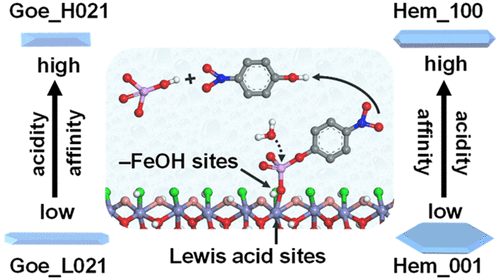当前位置:
X-MOL 学术
›
Environ. Sci. Technol.
›
论文详情
Our official English website, www.x-mol.net, welcomes your
feedback! (Note: you will need to create a separate account there.)
Enhanced Hydrolysis of p-Nitrophenyl Phosphate by Iron (Hydr)oxide Nanoparticles: Roles of Exposed Facets.
Environmental Science & Technology ( IF 10.8 ) Pub Date : 2020-06-16 , DOI: 10.1021/acs.est.9b07473 Tong Li 1 , Wen Zhong 2 , Chuanyong Jing 2 , Xuguang Li 1 , Tong Zhang 1 , Chuanjia Jiang 1 , Wei Chen 1
Environmental Science & Technology ( IF 10.8 ) Pub Date : 2020-06-16 , DOI: 10.1021/acs.est.9b07473 Tong Li 1 , Wen Zhong 2 , Chuanyong Jing 2 , Xuguang Li 1 , Tong Zhang 1 , Chuanjia Jiang 1 , Wei Chen 1
Affiliation

|
Iron (hydr)oxide nanoparticles are one of the most abundant classes of naturally occurring nanoparticles and are widely used engineered nanomaterials. In the environment these nanoparticles may significantly affect contaminant fate. Using two goethite materials with different contents of exposed {021} facet and two hematite materials with predominantly exposed {001} and {100} facets, respectively, we show that exposed facets, one of the most intrinsic properties of nanocrystals, significantly affect the efficiency of iron (hydr)oxide nanoparticles in catalyzing acid-promoted hydrolysis of 4-nitrophenyl phosphate (pNPP, selected as a model organophosphorus pollutant). Attenuated total reflectance Fourier-transform infrared spectroscopy analysis and density functional theory calculations indicate that the pNPP hydrolysis reaction on the iron (hydr)oxide surface involves the inner-sphere complexation between the phosphonate moiety of pNPP and the surface ferric iron (Fe(III)), through ligand exchange with primarily the singly coordinated surface hydroxyl groups of iron (hydr)oxides. Both the abundance and affinity of these adsorption sites are facet-dependent. Exposed facets also determine the reaction kinetics of surface-bound pNPP mainly by regulating the Lewis acidity of the surface Fe(III) atoms. These findings underline the important roles of facets in determining the reactivity of naturally occurring metal-based nanoparticles toward environmental contaminants and may shed light on the development of nanomaterial-based remediation strategies.
中文翻译:

铁(羟基)氧化物纳米颗粒增强的对硝基苯基磷酸酯的水解:暴露面的作用。
(氢氧化)铁纳米粒子是天然纳米粒子中最丰富的类别之一,并且是广泛使用的工程纳米材料。在环境中,这些纳米颗粒可能会严重影响污染物的归宿。分别使用两种具有不同含量{021}裸露面的针铁矿材料和两种主要具有{001}和{100}裸露面的赤铁矿材料,我们发现裸露的面(纳米晶体最固有的特性之一)会显着影响效率(氢氧化)铁纳米颗粒催化4-硝基苯基磷酸(pNPP,被选作模型有机磷污染物)的酸促进水解。衰减全反射傅里叶变换红外光谱分析和密度泛函理论计算表明,氧化铁(p)上的pNPP水解反应涉及pNPP的膦酸酯部分与表面三价铁(Fe(III))之间的内球络合。 ),主要是通过与(铁)氧化物的单配位表面羟基进行配体交换。这些吸附位点的丰度和亲和力均取决于刻面。暴露的面还主要通过调节表面Fe(III)原子的路易斯酸度来决定表面结合的pNPP的反应动力学。
更新日期:2020-07-21
中文翻译:

铁(羟基)氧化物纳米颗粒增强的对硝基苯基磷酸酯的水解:暴露面的作用。
(氢氧化)铁纳米粒子是天然纳米粒子中最丰富的类别之一,并且是广泛使用的工程纳米材料。在环境中,这些纳米颗粒可能会严重影响污染物的归宿。分别使用两种具有不同含量{021}裸露面的针铁矿材料和两种主要具有{001}和{100}裸露面的赤铁矿材料,我们发现裸露的面(纳米晶体最固有的特性之一)会显着影响效率(氢氧化)铁纳米颗粒催化4-硝基苯基磷酸(pNPP,被选作模型有机磷污染物)的酸促进水解。衰减全反射傅里叶变换红外光谱分析和密度泛函理论计算表明,氧化铁(p)上的pNPP水解反应涉及pNPP的膦酸酯部分与表面三价铁(Fe(III))之间的内球络合。 ),主要是通过与(铁)氧化物的单配位表面羟基进行配体交换。这些吸附位点的丰度和亲和力均取决于刻面。暴露的面还主要通过调节表面Fe(III)原子的路易斯酸度来决定表面结合的pNPP的反应动力学。











































 京公网安备 11010802027423号
京公网安备 11010802027423号